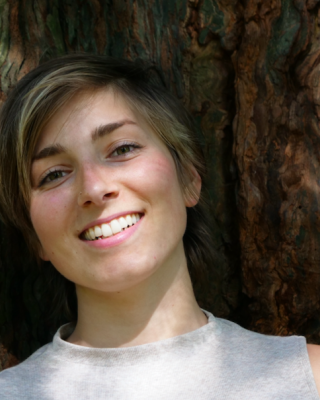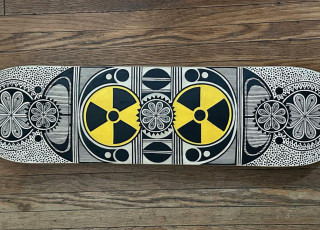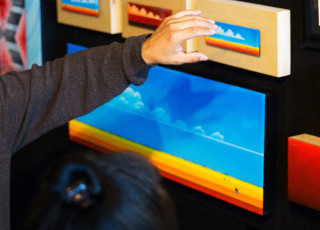Reconnecting to Indigenous Roots Through Art
By Jude Coleman

Photo by Jack Rodgers
When silversmith Sarena Boyd was growing up in Ogden, her grandmother would come to visit with a box of handmade Navajo jewelry in hand. Boyd loved looking through the tiny chunks of strung turquoise, destined to be sold. They were the first seeds that grew into her jewelry career. “My Navajo roots stem from my dad's side,” she said. “When I found jewelry making, it was something that had been in my family.”
Years later, Boyd took a single jewelry making class at a rock shop — and immediately fell in love with the craft, buying her own supplies later that day. Since then, she’s been completely self-taught, learning metal work and lapidary skills as she went. Now, over a decade later, Boyd’s rings, necklaces and earrings are a reflection of her Navajo heritage, each artfully crafted around a piece of that background.

Boyd will be a vendor this year at NHMU’s Indigenous Art Market & Festival. Visitors can stop by October 11 and 12 from 10 a.m. to 5 p.m. to meet 50 artists and shop the market.
One piece that is a prime example of her thoughtful work is her Starry Night earrings. The silver cross-shaped cutouts represent stars and constellations, inspired by a Navajo creation story about Coyote and the night sky. The story tells that during the creation of the galaxy, the Holy Beings were placing pieces of crystals among the heavens to light up the night. They carefully placed them into the North Star and constellations, while Coyote — known for being a trickster — sat by and watched. Coyote wanted to help and placed a few stars himself, but became impatient. He took the bag of crystals and threw them all into the sky at once, making a smattering of stars around the constellations. To create the Starry Night earrings, Boyd started with a thin sheet of silver with the design laid out on top. Using a drill, she punched out holes that would later fit a teeny, tiny saw — the blade so thin it looks like a piece of wire. She then carefully cut out each piece and filed down the rough edges. “The saw blades sometimes come off the silver really quick and just hit my finger, but it won't bleed because it's so calloused.”

Photo by Jack Rodgers
Those callouses are the result of another aspect of her trade: lapidary work. Boyd cuts and shapes all her stones herself, which means her fingers are in regular contact with abrasive wheels coated with diamond and resin. Many of her pieces use turquoise, variscite or opal, three of her favorite stones. She sources her stones from rock and mineral shows, often buying them directly from the rockhounds that dug them up. Most pieces start with a large chunk of rock that she cuts down into a slab with a (much bigger) saw. Then, she cuts out individual pieces, which are further shaped and polished by a series of grinding belts. Once a stone is shaped, she sets it into silver by soldering together a backplate and bezel band that hold the stone in place.

Photo by Jack Rodgers
These stones can then be set onto a ring, or strung onto a chain, such as on her Path Home necklace. The necklace centers on a teardrop-shaped piece of turquoise, with a cross-shaped star — similar to the Starry Night design — above. The design is again inspired by Navajo stories Boyd has learned, and represents the four directions, the stars, and a compass pointing her in the right direction. It reflects her background with a contemporary take, she said. “You can tell it's not traditional…but you can tell it's native.”
Between sawing and sanding stones and soldering fiddly pieces of silver, the jewelry making process has taught her a lot of patience. She still gets nervous before cutting out stones, she said. There’s a lot that can go wrong in each step of the process, which could result in pivoting to a different vision or scrapping a piece entirely and completely starting over.
Even the staging for her photos is filled with intention. Pieces often sit on a deer antler she found while camping, and may feature dried flowers from her late uncle’s house or a rabbit pelt. These details come together to further embody her values as a creative, honoring the nature around us. Boyd sells her jewelry at markets, like NHMU’s, and through her online store and Instagram, @taveenjewelry. When she’s not making jewelry, Boyd works as a graphic designer for Sacred Circle Healthcare, an Indigenous-owned clinic that provides healthcare to underserved communities.
For Boyd, her work has been a way to connect with a culture that she was unsure of her place in. Growing up outside of the Navajo Nation, she didn’t have a lot of traditional upbringings. This led her to feel disconnected, she said. But her jewelry has created a path for her to come back to Navajo culture; she’s dedicated herself to learning the language, stories and customs. “There’s a lot of self-discovery in my jewelry,” she said. “[It’s] been a journey of discovering me as an indigenous Navajo woman and being very confident of who I am.”
Indigenous Art Market & Festival
Meet Sarena among 50 artists who will be selling their work at NHMU's Indigenous Art Market & Festival on October 11 and 12 from 10 a.m. to 5 p.m. each day. Learn more and prebook tickets here.




